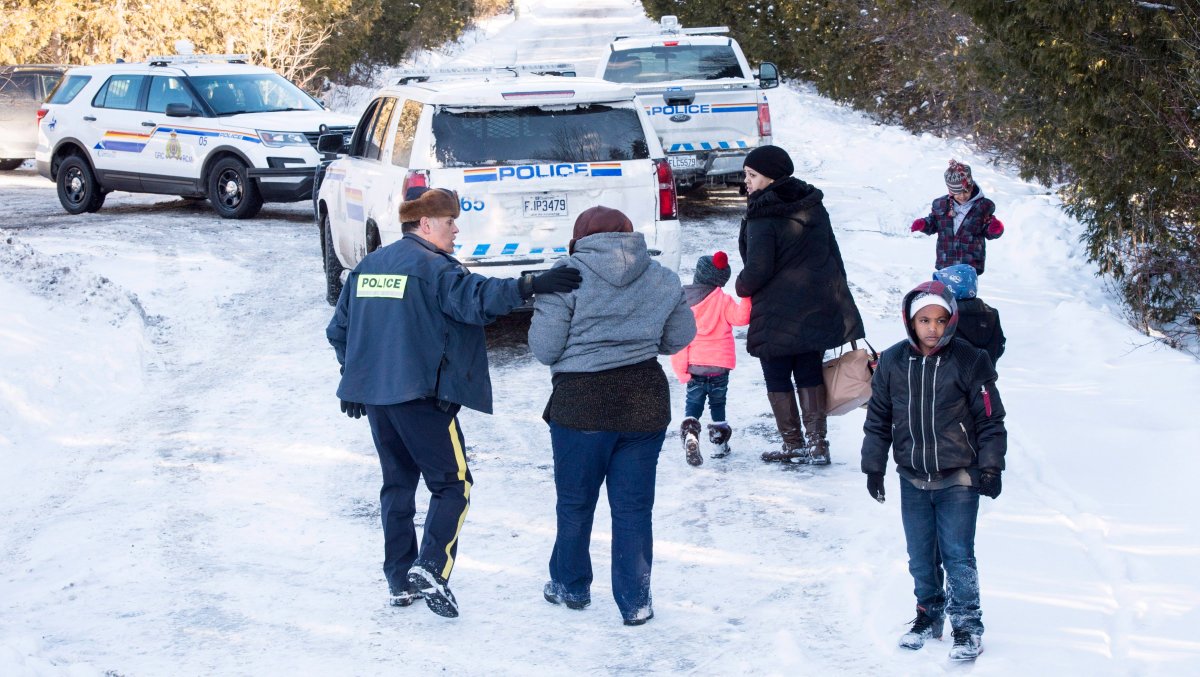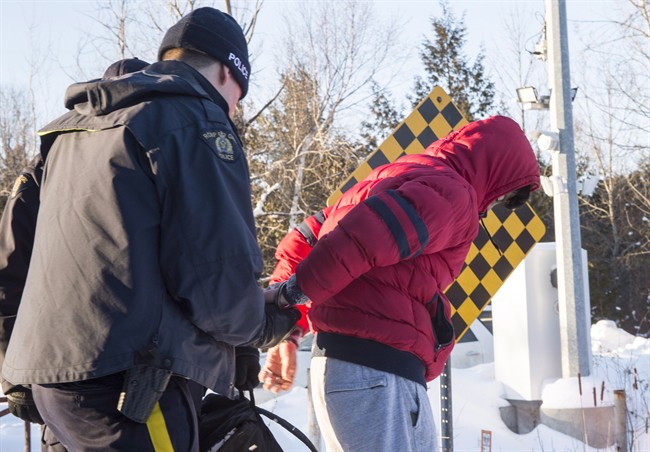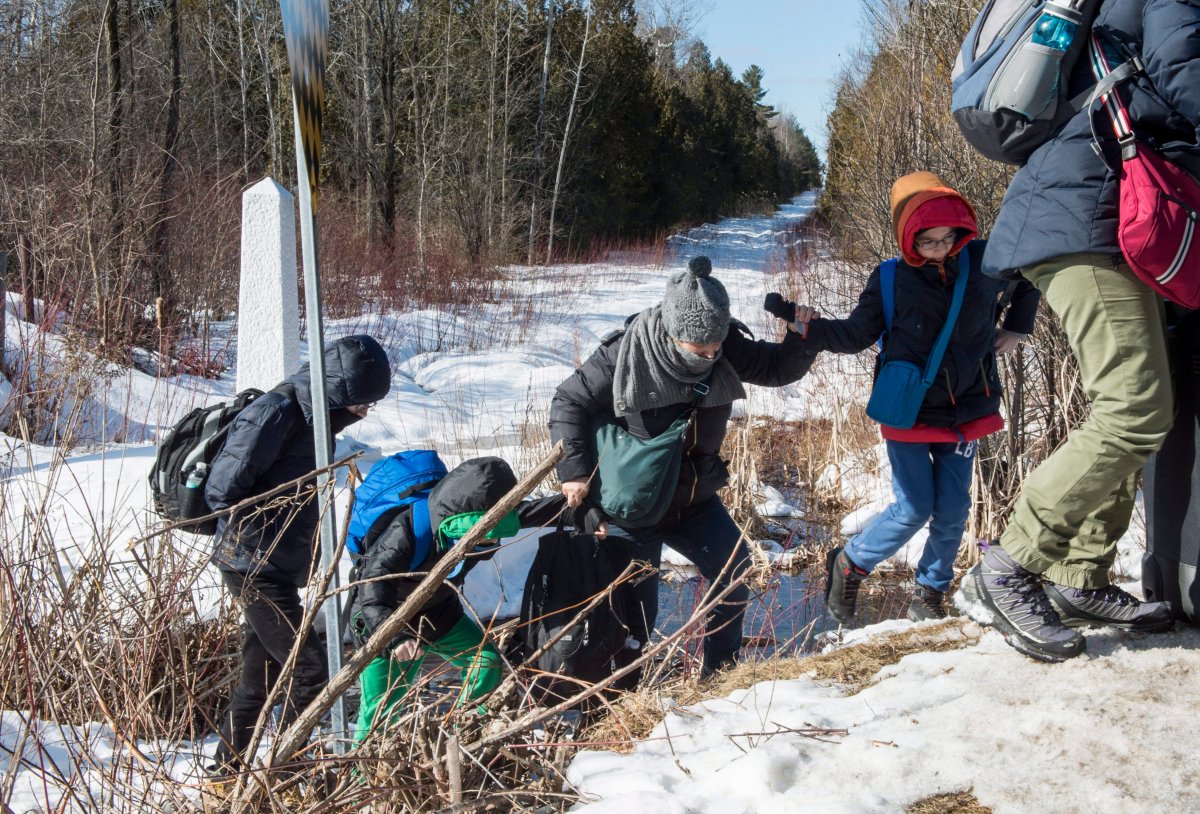The men, women and children hiking over the Canada-U.S. border to seek asylum in Canada are risking more than freezing conditions – they’re cutting off all roads back to the United States and risk being sent back to the countries they fled.

“Usually the U.S. is considered a safe place to seek asylum,” said Jacqueline Bonisteel, an associate at Corporate Immigration Law Firm in Toronto.
“It’s a high risk, but for these people Canada seems to be a safer place to make a claim.”
Every one of the dozens and dozens of asylum seekers who’ve recently arrived – and continue to arrive – on Canadian soil has a right to seek refugee status in Canada. This is on account of Canada signing on to the UN Refugee Convention.
But that doesn’t necessarily mean they’ll be accepted.
READ MORE: Why are asylum seekers crossing into Canada on foot and what are their rights?
When a person makes a claim for refugee protection, an officer with the Canada Border Services Agency first interviews, fingerprints, photographs and runs a background check on the claimant.
If eligible, the claimant’s file is referred to the Immigration and Refugee Board; if the application is ineligible, the person “may be removed from Canada to their country of citizenship,” a spokesperson with the CBSA said.
WATCH: Italian immigrant shares his journey amidst asylum seekers arriving to Winnipeg

In 2015, more than 6,400 claims referred to the Immigration and Refugee Board were either rejected (5,332) or withdrawn (1,085), according to data the board provided to Global News.
A claim can be withdrawn by the government if it determines the individual is excluded from pursuing refugee status on account of war crimes or organized crime, for example, or by the claimant. If a client dies, their application is also considered withdrawn.
READ MORE: Lack of resources makes border ‘vulnerable’ as refugees pour in: CBSA union
In 2014, a total of 9,227 applications referred to the board were either rejected (7,756) or withdrawn (1,471). From January to September 2016, 4,394 applications were either rejected (3,658) or withdrawn (736). Final numbers for 2016 will only become available in April, a spokesman for the board said.
A claimant has certain rights upon arriving in Canada, but they have to prove they warrant refugee status.
“You have to prove your life is at risk, that there’s a personalized risk, a risk of persecution from any country where you can be removed,” said Alastair Clarke, a lawyer with Clarke immigration Law in Winnipeg.
Roads to U.S. close
If a rejected asylum seeker in Canada has no status in the U.S., they cannot return there. Moreover, they’re prohibited from going to America because of the Safe Third Country Agreement between the two countries, which forces people to apply for asylum in the first country they arrive – not both.
There are few exceptions to the agreement, mostly with an eye on keeping families together. But there is a loophole. If a person crosses at an unguarded portion of the border (as much of the almost 8,900-kilometre border is) they will not immediately be turned away. Instead, they will be arrested and start a claims process.
READ MORE: Recent asylum seekers speak to Global News about journey to Canada
The Canadian government has faced pressure to repeal the agreement since U.S. President Donald Trump issued an executive order banning travel and immigration from seven Muslim-majority countries, many aspects of which were stayed by courts. Trump is expected to sign an amended order soon.
Canada’s government has so far refused to touch the agreement, saying the parameters remain intact despite any fears refugees and illegal immigrants in the U.S. are exhibiting.
Clarke noted that refugees are avoiding coming through border crossing points because they fear that if they get turned away from the border due to the Safe Third Country Agreement, they won’t be able to file for refugee status in Canada later on.
WATCH: Ottawa refuses to close loophole asylum seekers using

Clarke recalled one of his clients who was a Russian-born Jew pursued by the mafia. She left Russia and moved to Israel, where she attained citizenship. She later fled to South Africa, where she also gained status, then came to Canada.
When she made her case before the Immigration and Refugee Board in Canada, Clarke had to make a separate argument on why his client’s life would be in danger for each country to which she could legally be removed, he said.
Who is coming to Canada?
At the end of 2015, more than 65 million people worldwide fled their home countries, trying to get away from war, violence, famine or get to a country that doesn’t persecute or kill homosexuals.
The number of refugees across the globe today is the highest since the end of the Second World War, according to the United Nations Refugee Agency.
In the first nine months of last year, the Immigration and Refugee Board received 16,279 referrals from the Canadian Border Services Agency and Immigration, Refugees and Citizenship Canada. (All numbers cited in this article do not include asylum seekers who were turned away prior to initiating a claim with the board. CBSA and IRCC did not make available the number of would-be claimants they turned away before opening a claim.)
Some of the countries with the highest representation of claimants include:
- China (1,022 referred, 464 rejected, 46 withdrawn)
- Nigeria (1,036 referred, 344 rejected, 12 withdrawn)
- Pakistan (792 referred, 126 rejected, 17 withdrawn)
- Iraq (755 referred, 93 rejected, 16 withdrawn)
- Syria (726 referred, 18 rejected, 14 withdrawn)
- Hungary (711 referred, 177 rejected, 98 withdrawn)
- Somalia (548 referred, 85 rejected, 23 withdrawn)
- Afghanistan (473 referred, 61 rejected, 14 withdrawn)
- India (428 referred, 205 rejected, 20 withdrawn)
- Burundi (358 referred 16 rejected, three withdrawn)
- Congo (291 referred 92 rejected, two withdrawn)






















Comments